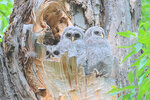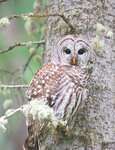Cloudy, 52° F
Jackson photojournalist and birder Tom Stanton was cross-country skiing in Grand Teton National Park in late April, looking for owls, when he heard an unfamiliar song. He froze.
“In …
This item is available in full to subscribers.
The Powell Tribune has expanded its online content. To continue reading, you will need to either log in to your subscriber account, or purchase a subscription.
If you are a current print subscriber, you can set up a free web account by clicking here.
If you already have a web account, but need to reset it, you can do so by clicking here.
If you would like to purchase a subscription click here.
Please log in to continue |
|


Jackson photojournalist and birder Tom Stanton was cross-country skiing in Grand Teton National Park in late April, looking for owls, when he heard an unfamiliar song. He froze.
“In my head, I was like, ‘I’ve never heard a great horned owl make that kind of noise,” he said. “But it was coming from an area where there had been a nesting pair of great horned owls a couple of years prior.”
Intrigued, he waited. “About a half hour later, they did what I call the monkey call,” hooting back and forth. “I was like, ‘I’ve never heard great horns do that.’”
He skied over to the old nest site. An owl flashed by in the corner of his vision, too fast to identify. But then he saw a cottonwood tree with the type of cavity owls use for nests. A stray feather lay near the opening.
Stanton did what any good birder would do: He returned the following day.
“I was kind of sitting watching the cavity from a distance,” he said. “And all of a sudden, up pops the barred [owl].”
There was a moment of cognitive dissonance, he said, because Wyoming isn’t barred owl habitat. There have been sightings, but they are rare. He could see the pairs’ distinctive black eyes, however, and used his birding app to confirm their songs.
These were barred owls.
Though he didn’t want to harass the birds, Stanton’s instinct was to document. So he returned to the site a couple days a week for the next few months to watch and photograph the pair calling, hunting, sleeping and eventually hatching two chicks. In doing so, Stanton documented Wyoming’s first breeding pair of barred owls.
The news will no doubt pique the interest of birders, who are known to travel on short notice to glimpse rare species. But biologists aren’t celebrating yet. The arrival of a non-native bird could have ramifications for the ecosystem’s other denizens, they say.
“We’ve definitely been apprehensive just because we kind of look at things from a bigger ecosystem-level picture,” Teton Raptor Center Associate Research Director Katherine Gura said. “And it’s hard to say what the impact is going to be on some of these other species that are really important in this ecosystem.”
Moving in?
Barred owls are similar in size to great horned owls, but lack the “horns.” They are similar in profile to great gray owls, but are smaller and have black eyes in contrast to the great grays’ distinct yellow ones. Though they are eastern birds, they have expanded their range westward through the boreal forests of Canada and down into the Pacific Northwest.
In Washington, Oregon and California, their negative impacts on federally protected northern spotted owls have created a high-profile management conundrum. Barred owls, which are territorial and eat a variety of prey, have edged out the shier and more specialized spotted owls. The U.S. Fish and Wildlife Service has wrestled with the issue for years, even experimenting with killing barred owls to make room for spotted owls.
Barred owls have also moved south from Canada into parts of Idaho and Montana. In Wyoming, there have been sightings of vagrant barred owls over the years, but never breeding pairs. Grand Teton National Park has 12 records of barred owls between 1982-1999, according to Public Affairs Officer Valerie Gohlke.
Wyoming Game and Fish Department Nongame Bird Biologist Zach Wallace wasn’t terribly surprised by the news, given their expansion. It’s too early to know what it means for the state, he said, as it might be an anomaly. Any rare bird record in the state is reported to the Wyoming Bird Records Committee for review, Wallace said.
“At this point, it’s one pair,” he said. “We just keep track of it.”
Grand Teton National Park intends to do the same, Gohlke said, monitoring the owls and their relationship with other species in collaboration with the Teton Raptor Center.
The management crisis in the Pacific Northwest, Wallace said, is “a really extreme situation with an endangered species. They’re doing management as a last resort, real ecological triage. And we have no reason to believe that would happen here.”
But Gura of the raptor center, who has been studying great gray owls and other raptors in the region for about a dozen years, is uneasy.
Her team discovered the owls independently of Stanton. They were conducting a prey survey one day this summer when a colleague came across one of the adults and then discovered a fledgling.
The Raptor Center team was “extremely surprised” by the discovery, Gura said. They were also concerned, “because of the potentially detrimental effects on the native raptors that we spend a lot of time researching and studying and working to conserve.”
What happened with barred and spotted owls is “highly concerning” to her.
“A lot of people have asked me, ‘what are the potential impacts going to be on great grays in relation to barred owls?’” she said. Because great grays are one of the least studied raptors, she said, there isn’t a ton of research to draw from in considering potential competition with barred owls.
“There’s just really a lot of unknowns,” she said. “Maybe they’ll be able to persist no problem, but there’s just the potential that there’s going to be a similarly negative impact on great grays as there has been on spotted owls.”
Soon after their discovery, Gura said, she connected with Stanton, who shared his research and documentation. The center’s plan is also to monitor and study what happens next.
Observations
They may be cast as villains in spotted owl habitat, but the barred owl family charmed Stanton as he observed them over the months.
He saw the male dive for voles, squirrels and songbirds and deliver them to the female. He watched as the adults preened and cackled together in greeting — behavior he said was downright affectionate. They checked in often with one another and were extremely vocal, he said.
Stanton glimpsed the first evidence the owls had successfully bred on the afternoon of June 28. That’s when a fluffball of gray feathers appeared at the edge of the cavity around 2:30 p.m. A second chick popped up about three hours later.
The female kept a close eye on them, he said. He figured they were 4 to 5 weeks old. After that, he watched the two chicks fledge — they started by hopping from limb to limb before graduating to flying farther distances behind their parents.
One of the chicks did not survive — its wing was discovered and it was likely taken by a predator, Stanton said. But he has consistently been able to find one of the remaining three.
All told, Stanton spent hundreds of hours watching the owls, taking thousands of photographs. It was certainly a remarkable wildlife experience, he said, a birding highlight. But Stanton is also aware that non-native immigrants can come with impacts.
“The big question is: How will it impact the great grays?” he asked.
(WyoFile is an independent nonprofit news organization focused on Wyoming people, places and policy.)